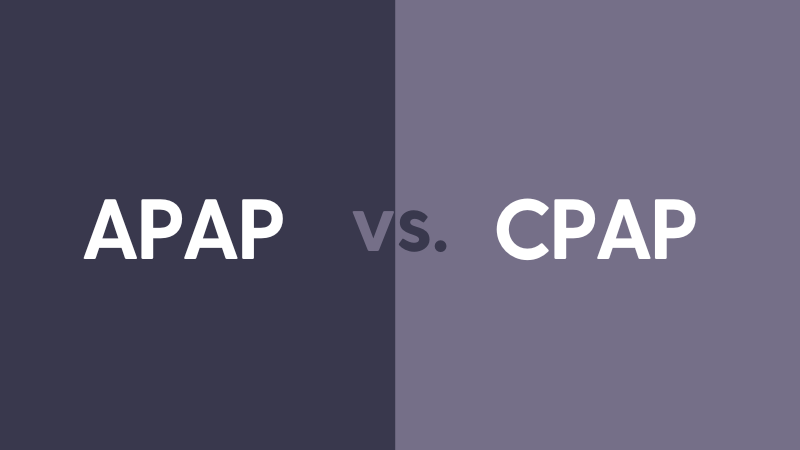
Join Our Email List!
Be the first to know about our latest special offers, promotions, company updates, and more!

Sleep apnea is a group of sleep disorders that causes frequent pauses in breathing during your sleep. The most common type is obstructive sleep apnea (OSA), defined by episodes of partial or complete blockages of your upper airway. If you’ve been diagnosed with OSA, you’ve likely been prescribed one of three types of therapy, CPAP (continuous positive airway pressure), APAP (automatic positive airway pressure), or BiPAP (bi-level positive airway pressure).
In this article, we’ll compare APAP vs. CPAP and go beyond what APAP stands for to help you understand why it matters as it relates to your therapy. Click one of the sections below to jump to it or keep reading:

The purpose of any treatment for OSA is to deliver pressurized air to your airway via your nose, mouth, or both throughout the night to keep your airway open, improving sleep quality. At the most basic level, what separates AutoPAP from CPAP is the level of pressure delivered and the way it’s delivered.
While APAP was originally used during a diagnostic sleep study to determine the best level of pressure for CPAP therapy, it’s now common to be prescribed APAP for continued use instead of CPAP for several reasons:
While pressure adjustments typically benefit APAP users for the reasons above, they can cause sleep disruptions for some. Airway restriction can also return if therapy pressure is lowered too much. Fortunately, most APAP machines collect and save therapy data, including the average and maximum pressure, which can be shared with your physician to help them determine if your prescribed pressure range is adequate and make adjustments as needed.
Both APAP and CPAP machines typically have settings that can be adjusted to make therapy more comfortable. The setting name varies by manufacturer, but three common examples are EPR, C-Flex, and A-Flex.
These settings help combat the feeling of breathlessness and shortness of breath some CPAP and APAP users experience when they struggle to breathe out against the incoming pressure.
Both forms of therapy are effective in treating sleep apnea and improving sleep quality, so the best option comes down to your personal needs and comfort. Your physician may recommend one or the other in their practice or may prescribe one based on initial discussions and the results from your sleep study. We recommend talking with them about the pros and cons of each.
If you’ve been diagnosed with sleep apnea and PAP is being considered, your sleep is being interrupted more than 15 times per hour. Both CPAP and APAP are effective in treating these interruptions in sleep, so you feel more rested, productive, and less fatigued throughout the day. Although it can take time to adjust to therapy, very few people prescribed PAP therapy are unsuccessful. Some people adjust better to the initiation of therapy with AutoPAP, but If you’ve been using CPAP successfully and comfortably, there’s no reason to switch to APAP.
Unlike obstructive sleep apnea, central sleep apnea (CSA) occurs when the brain doesn’t send the right signals to the muscles that control your involuntary breathing. As a result, APAP and CPAP therapy can prove ineffective in treating CSA. If you have documented CSA, a sleep physician may do further sleep studies or prescribe a more complex pressure therapy device. If your data from using a CPAP or APAP machine shows increased central apnea or a continued high frequency of interrupted sleep despite airway restriction being resolved, your provider may also change your therapy device.
In most cases it’s possible to switch from one form of therapy to the other. Many of the best APAP machines can deliver either APAP or CPAP therapy, so you may not even need to buy a new device. Talk with your physician if you feel one type of therapy would be better for you.
Correction of sleep apnea events can be seen within the first night of use and a decrease in symptoms is typically noted within the first 2-4 weeks of therapy. The key is staying consistent with your therapy, so do your best to stay patient as you adjust to the feeling of the therapy pressure and the mask on your face.
The cost of APAP vs. CPAP therapy is typically about the same. Out-of-pocket costs when submitting through health insurance are similar for both machine types, and often the same machine can deliver either form of therapy. Check with your insurance or ask for a quote of costs when looking for a machine. The same masks and tubing can often be used for both forms of therapy as well, especially if made by the same manufacturer.
Once you talk with your physician and identify the right type of therapy to treat your OSA, determine if you have the right equipment. We’ve shared our recommendations for the best CPAP/APAP machines and best CPAP masks based on clinical experience and feedback from patients if you need a place to start.
If you have any questions about our products, our customer service team and will be happy to help.